
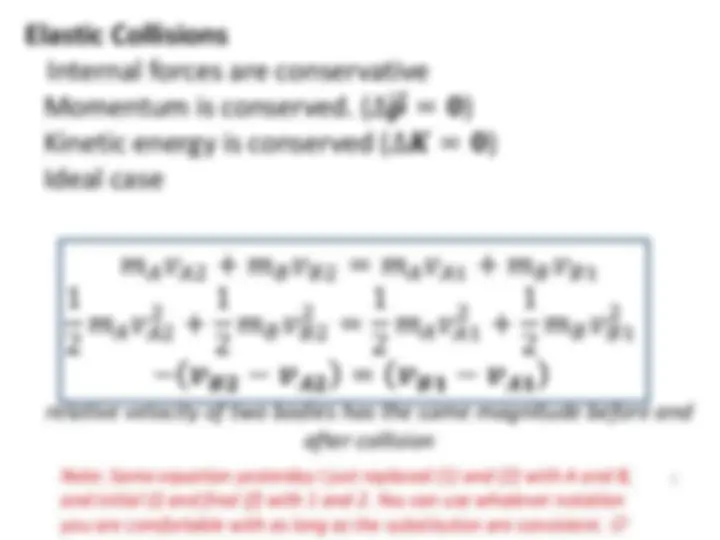
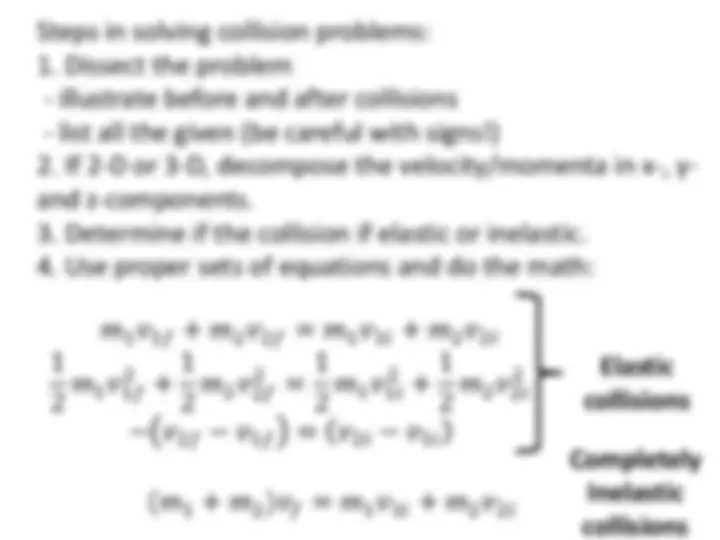
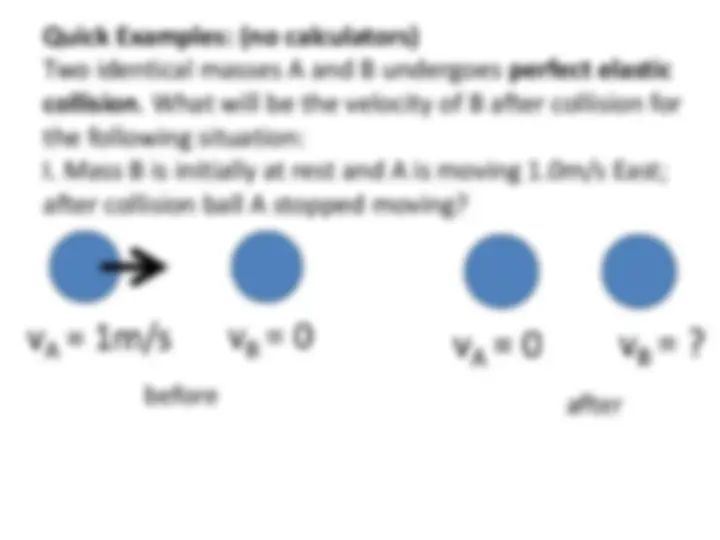
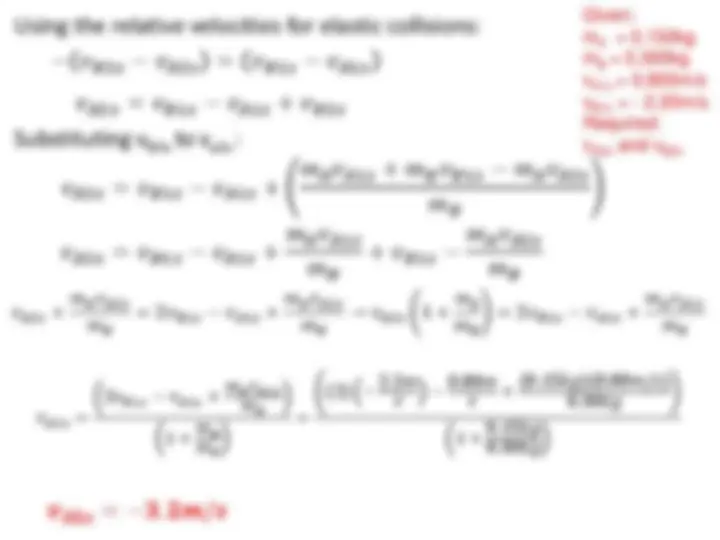
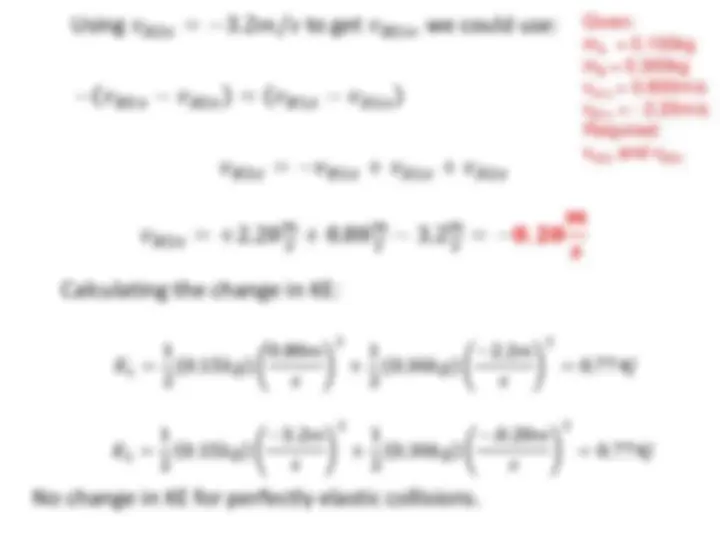
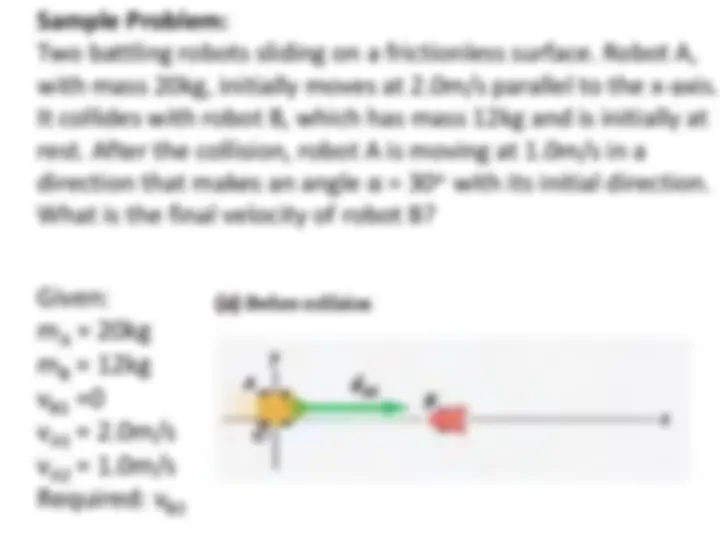
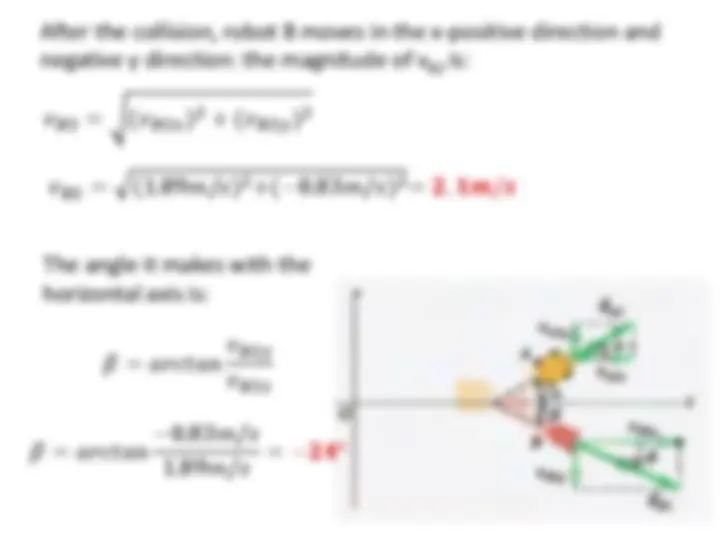
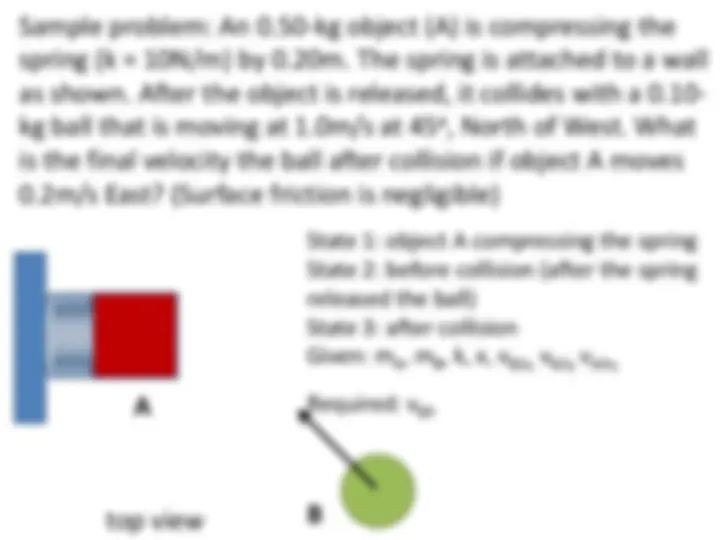
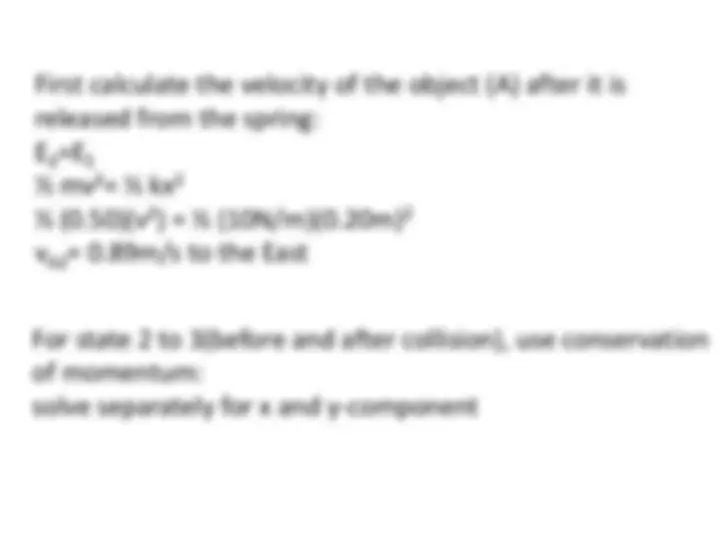
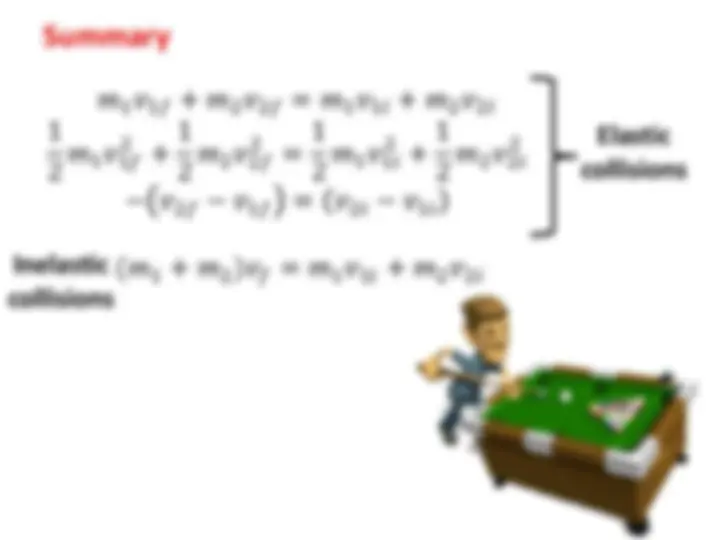

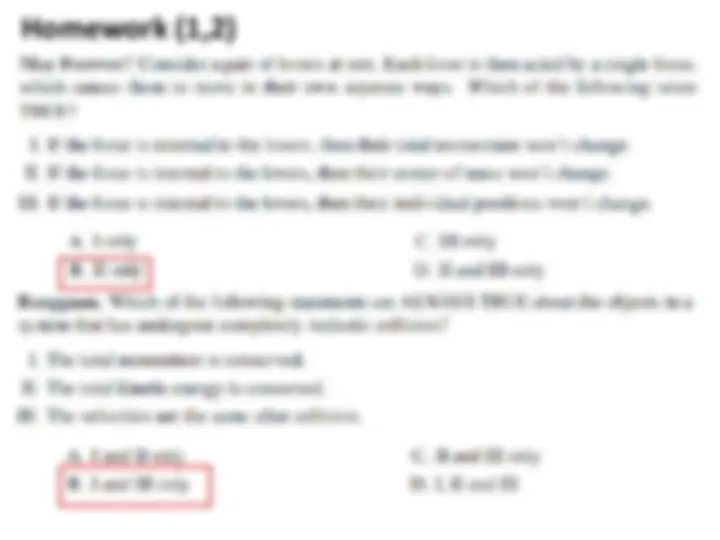
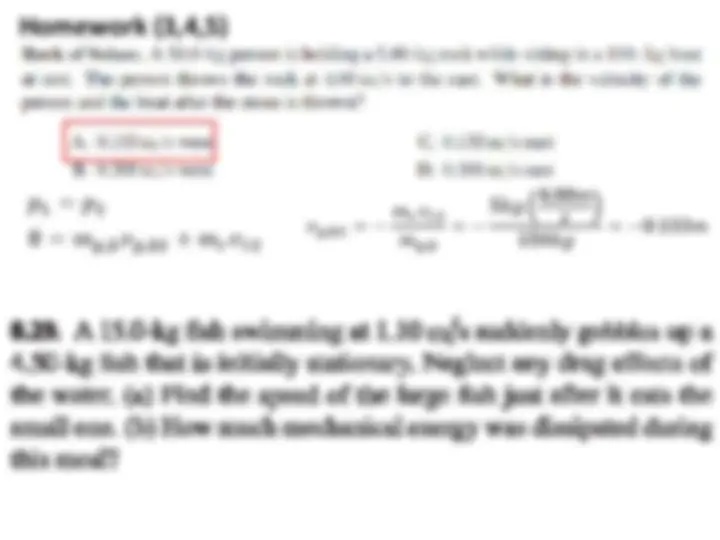
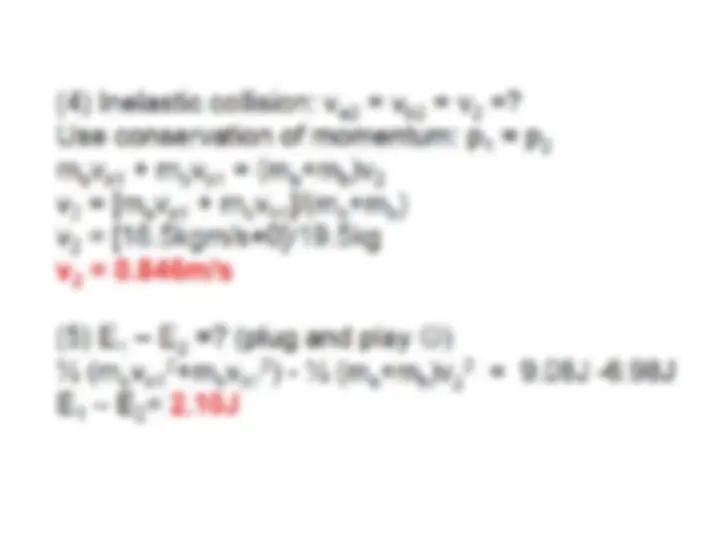
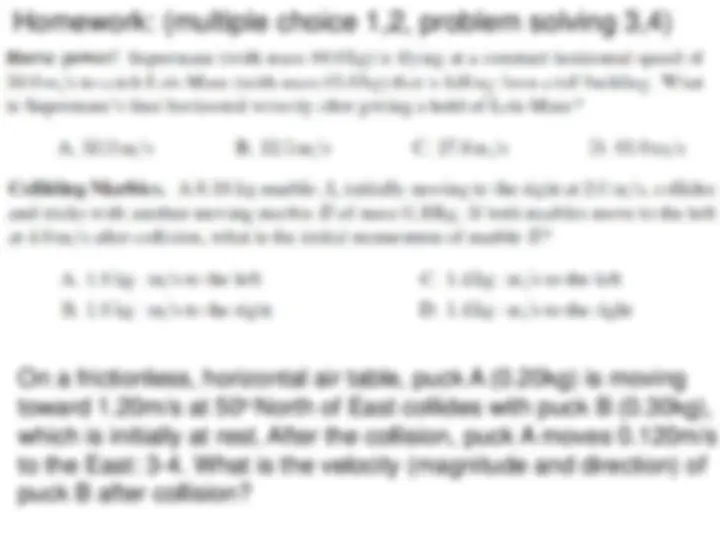


Study with the several resources on Docsity

Earn points by helping other students or get them with a premium plan


Prepare for your exams
Study with the several resources on Docsity

Earn points to download
Earn points by helping other students or get them with a premium plan
Community
Ask the community for help and clear up your study doubts
Discover the best universities in your country according to Docsity users
Free resources
Download our free guides on studying techniques, anxiety management strategies, and thesis advice from Docsity tutors
this is a powerpoint presentation on collisions
Typology: Slides
1 / 23

This page cannot be seen from the preview
Don't miss anything!
















Completely Inelastic Collisions
2
(𝒎𝑨 + 𝒎𝑩)𝒗𝟐 = 𝒎𝑨𝒗𝑨𝟏 + 𝒎𝑩𝒗𝑩𝟏
Note: Same equation yesterday I just replaced (1) and (2) with A and B, and initial (i) and final (f) with 1 and 2. You can use whatever notation you are comfortable with as long as the substitution are consistent.
Given: mA = 0.150kg mB = 0.300kg vA1x = 0.80m/s vB1x = - 2.20m/s Required: vA2x and vB2x
Using conservation of total momentum in x-component to get vB2x:
2 unknowns (vA2x, vB2x)
− 𝑣𝐵2𝑥 − 𝑣𝐴2𝑥 = 𝑣𝐵1𝑥 − 𝑣𝐴1𝑥 rel. velocity
Using the relative velocities for elastic collisions:
Substituting vB2x to va2x :
Given: mA = 0.150kg mB = 0.300kg vA1x = 0.800m/s vB1x = - 2.20m/s Required: vA2x and vB2x
𝑣𝐴2𝑥 + 𝑚𝐴 𝑚𝑣𝐴2𝑥 𝐵
= 2𝑣𝐵1𝑥 − 𝑣𝐴1𝑥 + 𝑚𝐴 𝑚𝑣𝐴1𝑥 𝐵
→ 𝑣𝐴2𝑥 1 + 𝑚𝑚𝐴 𝐵
= 2𝑣𝐵1𝑥 − 𝑣𝐴1𝑥 + 𝑚𝐴 𝑚𝑣𝐴1𝑥 𝐵
𝑣𝐴2𝑥 =
2𝑣𝐵1𝑥 − 𝑣𝐴1𝑥 + 𝑚𝐴 𝑚𝑣𝐵𝐴1𝑥 1 + 𝑚 𝑚𝐴𝐵
=
2 − 2.2𝑚𝑠 − 0.80𝑚𝑠 + (0.15𝑘𝑔)(0.80𝑚/𝑠)0.30𝑘𝑔
1 + 0.15𝑘𝑔0.30𝑘𝑔
Sample Problem:
Two battling robots sliding on a frictionless surface. Robot A,
with mass 20kg, initially moves at 2.0m/s parallel to the x-axis.
It collides with robot B, which has mass 12kg and is initially at
rest. After the collision, robot A is moving at 1.0m/s in a
direction that makes an angle α = 30o^ with its initial direction.
What is the final velocity of robot B?
Final velocity vB2 has x and y components: We must get for vB2x and vB2y to solve for vB
Apply conservation of momentum in x component to get vB2x
Apply conservation of momentum in y component to get vB2y
𝑣𝐴2𝑥 = 𝑣𝐴2𝑐𝑜𝑠𝛼 𝑣𝐴2𝑦 = 𝑣𝐴2𝑠𝑖𝑛𝛼
After the collision, robot B moves in the x-positive direction and negative y direction: the magnitude of vB2 is:
The angle it makes with the horizontal axis is:
State 1: object A compressing the spring State 2: before collision (after the spring released the ball) State 3: after collision Given: mA, mB, k, x, vB2x, vB2y vA3x,
Required: vB
Given: mA = 0.5kg mB = 0.1kg vB2 = 1.0m/s (45o) vA2x = 0.89m/s vA2y =0; vA3y = vA3x = 0.20m/s vB3 =???
𝑣𝐵2𝑥 =
0.5𝑘𝑔 0.89𝑚𝑠 − 0.1𝑘𝑔 1.0𝑚𝑠 𝑐𝑜𝑠45 − (0.5𝑘𝑔)(0.2𝑚𝑠 ) 0.1𝑘𝑔 = 𝟐. 𝟕𝐦/𝐬
𝑣𝐵2𝑦 =
0.5𝑘𝑔 0 + 0.1𝑘𝑔 1.0𝑚𝑠 𝑠𝑖𝑛45 − (0.5𝑘𝑔)(0) 0.1𝑘𝑔
= 𝟎. 𝟕𝟏𝒎/𝒔
For the x-component the conservation of total momentum gives:
For the y-component the conservation of total momentum gives: